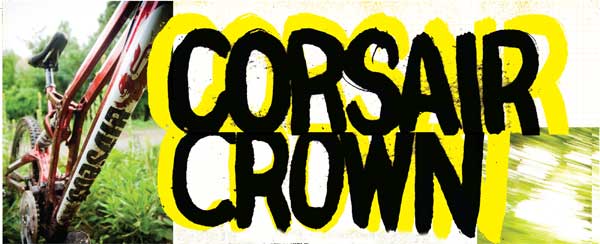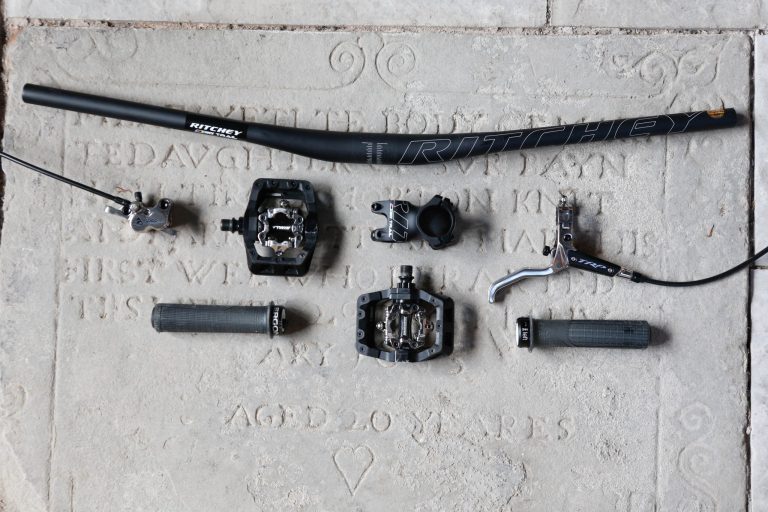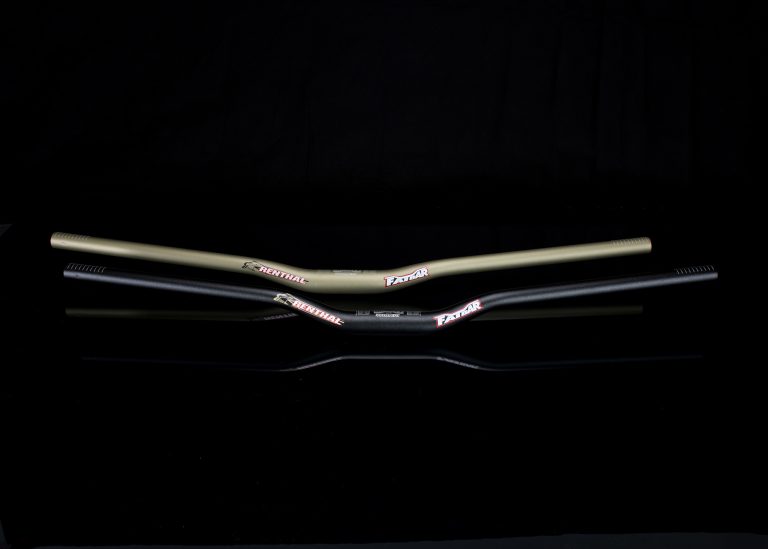
Bike Test: 2STAGE ELITE9
It’s not often that we get the chance to ride a bike from New Zealand, so when the opportunity arose we jumped at the chance. 2Stage is a relatively new company and even though it was only in 2006 that owner David Evans released the downhill bike the Elite 9 onto the market they have already made their mark. Raced successfully by Glenn Haden, Tom Deacon and Jess Stone the company is continually developing their bikes and range to such a degree that they now have a UK based office run by Peter Evans who is looking to expand the distribution network.
What is it about then? Well two air shocks drive two single pivots, the aim of which is said to “explore a stable platform equation where the threshold would be derived from rider input, rather than designating the terrain to blow–off a pre-determined platform”. In terms of practicalities, there’s one shock for small bumps (up to 5” travel) and the other shock for big bumps (last 40%). 2Stage point out that the second shock locks out for pedalling efforts, but that the first shock remains active for the bumps. I kind of grasped this not too complex design yet the word equation kept ringing in my head.

FEATURES
Slightly unexpected, but by far the easiest part of the 2Stage experience, was getting a working damping configuration. It was all positively straight–forward. The bike worked outstandingly well, the set–up was pretty much bang on, with clear thoughts pretty much all around. However, having been presented with a substantial amount of reading material, lets get a few of the key selling points of this rather different downhill bike…so just in case I missed something: “Two shocks, two stages, two pivots, two axle paths. Its as simple as that.” 2 shocks.
The company recommends using the shocks that come with the bike and so what we have here is a pair of Manitou air cans. The Evolver ISX–4 on the first stage deals with small hits and a Radium R has the job of managing larger impacts. 2Stage recommend base settings, so even though the Evolver has potentially 4 Volume adjustments, SPV pressure, rebound and air spring adjustment the info they give you is pretty spot on in terms of the dampers themselves. The second stage shock is a little more crude, with just air pressure and rebound. Both are said to be custom tuned for the bike, but most importantly have a seamless transition. This is certainly something that we were impressed with. 2 pivot points. Lower pivot for small bumps gives a shorter chainstay, whilst the higher pivot leads to a lengthening chainstay for stability.
We wondered whether it was substantial enough to have an effect on the handling geometry and was slightly confusing with the ‘constant wheelbase’ that they talk of later in the description. 2 axle paths. You thought it was hard enough figuring out all the complexities surrounding one? Well here’s a brace! The first is ‘mostly vertical’ and the second is rearward, aimed at dealing with the larger square edge bumps. Idler Function. We’re seeing more and more idlers on bikes these days, something Vouilloz was using almost a decade hence.
On the 2Stage it routes the chain between the two pivots keeping suspension active and locking out at the necessary moments. Lockout Function. “Chain tension provided a lock out function of the second stage shock limiting the travel of the system by half (but) the first stage shock will still be active”. 2 rebound speeds. It seems as though 2Stage prefer the first shock to be set fast for small bumps and the second shock slower so the rider doesn’t get bucked after a hard landing. Square edge bumps are said to be dealt with largely by the rearward axle path with no loss in momentum or stalling effect. Jump Pop. This is a new one. The high– pressure spring that is a feature of the second shock is said to give an excellent ‘pop’ off jumps.
Floating brake uncouples the braking from the suspension and so the suspension should never get harsh. Constant wheelbase. Even though they earlier say that the first shock works around a largely vertical axle path the 2Stage is said to have a constant wheelbase. However they later say that the axle path is rearward and upward and compliments the action of the fork so that the wheelbase never gets shorter and stability is greatly improved. Simplicity and low maintenance. Even though the 2Stage only has four pivot bolts they forget that it has two shocks. Hardly low maintenance.

REALITY AND RIDING
Obviously there are other features in a bike other than those above that are just as relevant – componentry, pricing, geometry and of course sizing for example, and in these departments there are positives and negatives. A tenner short of four grand ain’t bad price wise, and there are some reasonable components in the package, but the one size will be an issue. The 45.5” wheelbase is incredibly short for a downhill race bike. The 2Stage was far from being the complex beast I expected in terms of set–up. Peter was able to get the bike set–up pretty close quickly and efficiently. The first stage shock, the one that deals with small bumps, is set to fifty percent sag and the second shock, that takes the big hits, is set to whatever pressure it takes to stop it bottoming. “If you can follow the instructions on the back of a 2–minute noodle pack, you can set up a 2Stage suspension correctly…it should take about the same time too.”
In a short space of time we had the suspension set up well for the track on which we were riding – slow, tight and extremely rocky. The performance damping wise was as good as a lot of bikes we take down here. There was just the right amount of pay out on the bigger hits and yet tracking on smaller impacts remained consistent. In the tight the 2Stage drew on its tight geometry to One idler, two pivot points. get out of corners quickly. Grip was excellent. Deeper into the stroke on bigger hits the bike felt stable, although there was a slight tendency for the steering to wander, which could be improved.
Overall, in the slow and tight however there was never a feel that you had to fight with the 2 Stage, it all came reasonably easy to hand. Certainly a key feature of this New Zealander is its speed across the ground. On flatter tracks it carries trail bike speed, it really is a place to gain huge amounts of time. I guess high pivot bikes always have this trait, but to have a five inch bike that can metamorphose into nine is something special. The five inches of first stage performed faultlessly on most of the terrain we encountered.
For the second part of our test we were eager to find out its performance on longer harder, faster terrain, the place that would really stress the rear end. To get speeds up we headed to Cwmcarn, no not the most glamorous location on wet days, but nevertheless real and having a good spread of impacts and speeds. Whilst the speed across ground is excellent, and no doubt aided by the clever design, the more fundamental things such as steering and stability were instantly an issue here in south Wales, as the bike felt a touch too lively up front and the rider had to be compensating forwards and rearwards for a bike that never seemed settled. Yes you can ride around this, but great bikes enable a rider to stand centrally and pretty much stay there. Longer and lower might be one of the first changes to prevent the rider from being slightly on edge. That said, moving down the hill it’s reasonably easy to adjust your riding, and what stood out was how effortless it was to get on the pedals in between sections – on the right track it’s easy to see how the Elite9 could raise a few places on the score sheet. But it was further down the hill that bothered us most. Into fast braking bumps and successive root and rock hits the 2Stage became a choppy ride. The suggested settings that worked on slow tracks became unstuck at speed – definitely ridden a lot better in that type of terrain.

TWO STAGE?
So are two shocks really that much better? Not when compared to the likes of Cane Creek and BOS single coil units. The bike has some good characteristics, notably its speed across the ground in certain conditions and surprising simplicity of set up, but overall things like sizing, slightly unsettled handling angles and that high–speed harshness that let it down. To a degree it seems you can ‘downhill’ standard air shocks dependant on track and rider, as there didn’t seem to be any massive dip in performance of the shocks themselves. The 2Stage definitely has potential, especially when you consider how bikes like the Yeti and Intense have been refined over the years, and having seen first hand how this small family run business operates and the passion behind them and the riders it shouldn’t be that far off.
For now though we feel a well designed linkage and/or quality damper can do the job as well and mostly better. Having two dampers and a linkage brings with it a layer of
complexity that 2Stage are still in the process of fine–tuning. z
Elite9 Frameset: £1990
Elite9 bike: £3990
www.2stagebikes.com

SECOND OPINION
Clearly I take the huge responsibility for writing a carefully considered, well researched second opinion seriously. This time I actually tried some real research and started with a Tinternet search to dig up some material on the 2Stage.
Whilst most basic principles of the bike design seem to make sense there were some that raised as many questions as answers (or perhaps were more towards the marketing hype end of the bullometer). OK, having failed miserably on the systematic analysis approach I decided to leave that bit to Jonesy and got on and rode it.
Next problem…my first ride of the 2Stage was on the seriously steep Llangollen NPS track, where judging the new bike was lower down
my list of priorities, as I was busy bouncing off large unmovable objects. However, one obvious characteristic was the professionalism of the 2Stage race set up and their enthusiastic support, a very encouraging sign for the after sales support from the small Kiwi company. Basic setup was straightforward, but I could imagine that fettling with the damping settings could become complicated when both shocks are considered as an integrated system.
A few uplifts at Cwmcarn were a much better environment to form an opinion. The distinct feel of the air shocks front and rear were (unsurprisingly) immediately evident, giving a slightly harsh ride when compared with coil springs, the upside of which was it seemed to carry speed well and skim across the top of bumps as opposed to sticking to the ground and reacting to every undulation. It did seem to give weight to the adage that the most comfortable bike is not always the fastest. Grip didn’t seem to suffer despite this characteristic.
With the sag set up as advised, the bike did seem to sit down in the travel on the back forcing a conscious adjustment of riding position to shift weight forward. This, I’m sure, could have been rectified with further suspension set–up time. Other minor criticisms would be the idler cog was noisy and seemed inefficient, and the bike seemed like a lot of effort to get up to speed. Steve did pick up on a transition between the first and second stage giving a strange characteristic under braking and braking bumps, which, I have to admit, I was pretty oblivious too.
The use of two shocks and two pivots is a relatively complex solution to the problem. I like analogies to make a point (I mostly end up comparing things in life with women making me look like a total sexist moron) and complexity is an example. At one end of the spectrum you get the dumb blonde (or any other hair colour of course in our PC world), who is straight forward enough even a bloke can understand them.
At the other end of the spectrum you get the ‘sophisticated’ ones, costly, high maintenance and don’t even bother trying to figure out what makes them tick as you’ll always be wrong. Both have their advantages. One is best suited to a pint down the pub whilst the other is the ideal option for a posh dinner party. Simpler may be better in many circumstances, but it’s difficult to definitively state an ideal. My point is (did I have one?) is that when it comes to bikes it’s important that the drawbacks of a complex design are outweighed by the increase in performance otherwise what’s the point? Twin shock designs are not new, but this is a new take. So when new designs pop up there is always the question of performance versus marketing hype. We need ‘out of the box’ ideas to push the sport forward and to find what may be the next de facto standard, but more often than not the best design is an evolution of conventional designs. I’m not entirely convinced whether the 2Stage design has the staying power, but having said that, at the time of writing this a 2Stage is leading the 2009 NPS Male Elite class and recently took the Maxxis Cup overall in the women’s, which are big statements about the performance of the bike.. z





